An Analysis of Gender Differences in Working Memory Performance
VerifiedAdded on 2022/08/26
|9
|2459
|43
Essay
AI Summary
This essay provides a comprehensive analysis of gender differences in working memory performance, drawing on various research studies. It explores the existing literature, highlighting conflicting findings on the impact of sex on cognitive abilities, specifically focusing on spatial and verbal memory tasks. The essay examines the influence of factors such as the n-back task, prefrontal cortex activity, and hormonal influences like testosterone on cognitive performance. It also discusses the role of the 2D:4D digit ratio as an indicator of prenatal hormone exposure and its relationship to working memory. The analysis includes a quasi-experimental study that found females performed better in the n-back task, contradicting some previous research. The essay concludes by acknowledging the limitations of the study and emphasizing the need for further research to resolve the existing inconsistencies in the field.
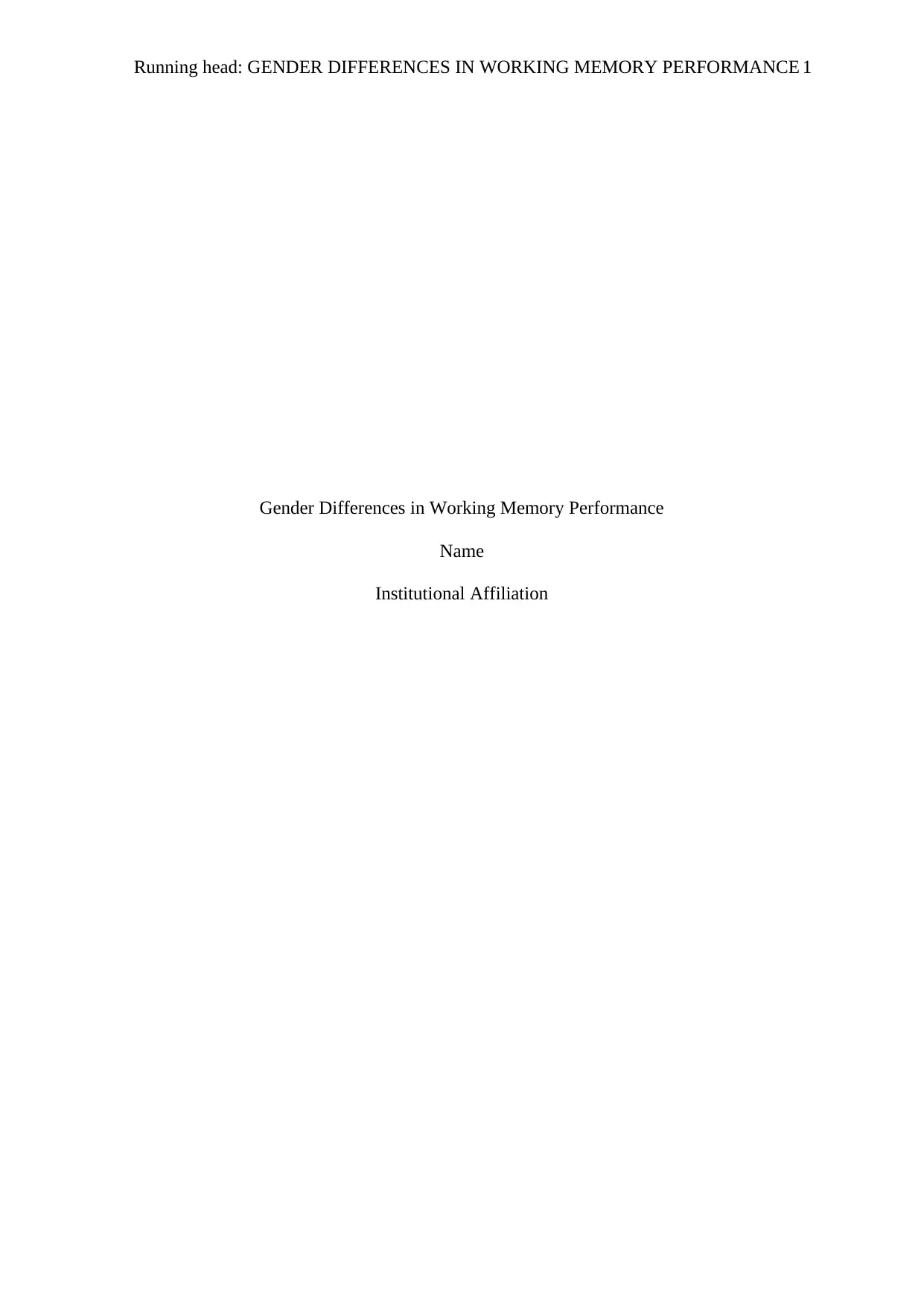
Running head: GENDER DIFFERENCES IN WORKING MEMORY PERFORMANCE 1
Gender Differences in Working Memory Performance
Name
Institutional Affiliation
Gender Differences in Working Memory Performance
Name
Institutional Affiliation
Paraphrase This Document
Need a fresh take? Get an instant paraphrase of this document with our AI Paraphraser
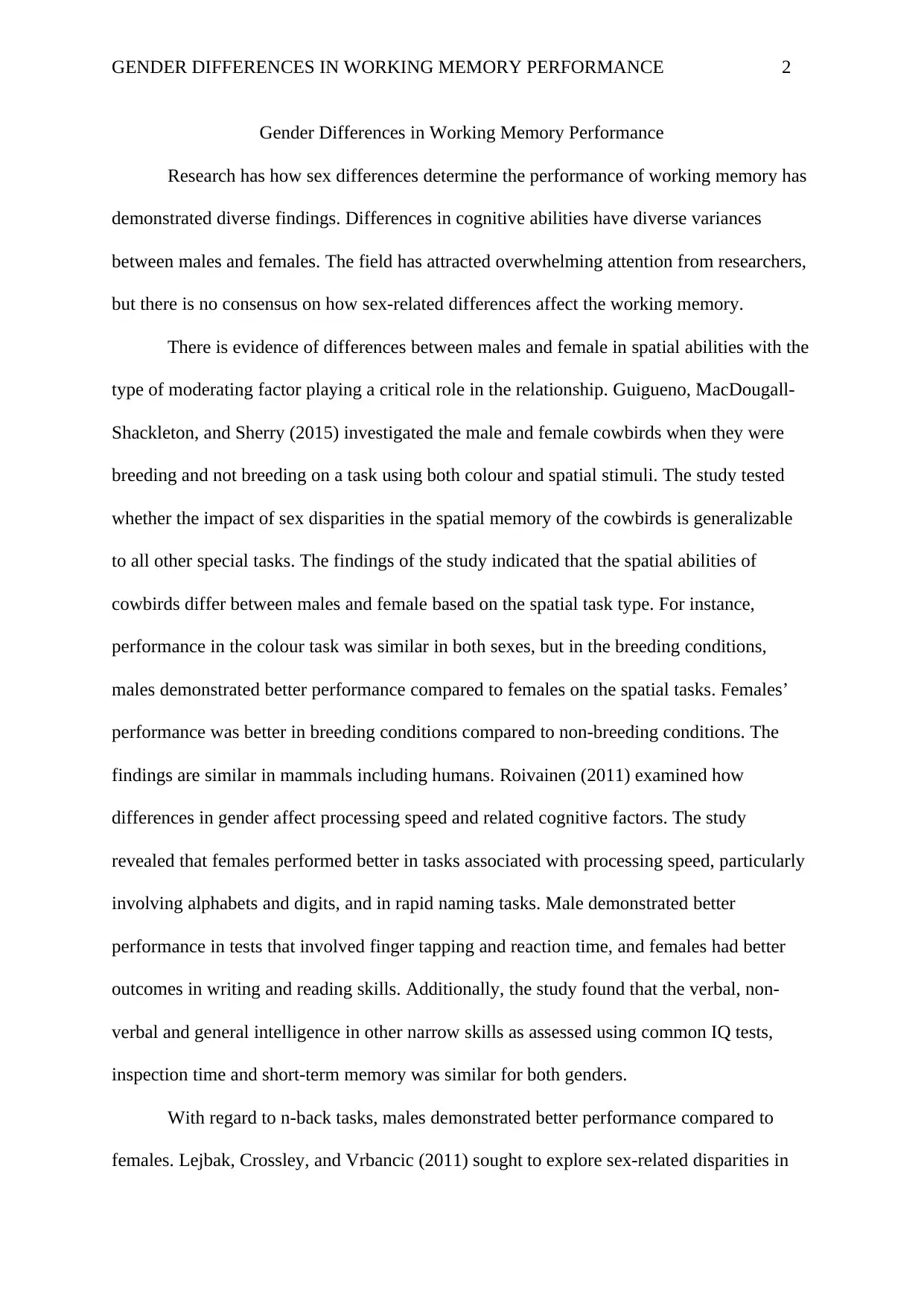
GENDER DIFFERENCES IN WORKING MEMORY PERFORMANCE 2
Gender Differences in Working Memory Performance
Research has how sex differences determine the performance of working memory has
demonstrated diverse findings. Differences in cognitive abilities have diverse variances
between males and females. The field has attracted overwhelming attention from researchers,
but there is no consensus on how sex-related differences affect the working memory.
There is evidence of differences between males and female in spatial abilities with the
type of moderating factor playing a critical role in the relationship. Guigueno, MacDougall-
Shackleton, and Sherry (2015) investigated the male and female cowbirds when they were
breeding and not breeding on a task using both colour and spatial stimuli. The study tested
whether the impact of sex disparities in the spatial memory of the cowbirds is generalizable
to all other special tasks. The findings of the study indicated that the spatial abilities of
cowbirds differ between males and female based on the spatial task type. For instance,
performance in the colour task was similar in both sexes, but in the breeding conditions,
males demonstrated better performance compared to females on the spatial tasks. Females’
performance was better in breeding conditions compared to non-breeding conditions. The
findings are similar in mammals including humans. Roivainen (2011) examined how
differences in gender affect processing speed and related cognitive factors. The study
revealed that females performed better in tasks associated with processing speed, particularly
involving alphabets and digits, and in rapid naming tasks. Male demonstrated better
performance in tests that involved finger tapping and reaction time, and females had better
outcomes in writing and reading skills. Additionally, the study found that the verbal, non-
verbal and general intelligence in other narrow skills as assessed using common IQ tests,
inspection time and short-term memory was similar for both genders.
With regard to n-back tasks, males demonstrated better performance compared to
females. Lejbak, Crossley, and Vrbancic (2011) sought to explore sex-related disparities in
Gender Differences in Working Memory Performance
Research has how sex differences determine the performance of working memory has
demonstrated diverse findings. Differences in cognitive abilities have diverse variances
between males and females. The field has attracted overwhelming attention from researchers,
but there is no consensus on how sex-related differences affect the working memory.
There is evidence of differences between males and female in spatial abilities with the
type of moderating factor playing a critical role in the relationship. Guigueno, MacDougall-
Shackleton, and Sherry (2015) investigated the male and female cowbirds when they were
breeding and not breeding on a task using both colour and spatial stimuli. The study tested
whether the impact of sex disparities in the spatial memory of the cowbirds is generalizable
to all other special tasks. The findings of the study indicated that the spatial abilities of
cowbirds differ between males and female based on the spatial task type. For instance,
performance in the colour task was similar in both sexes, but in the breeding conditions,
males demonstrated better performance compared to females on the spatial tasks. Females’
performance was better in breeding conditions compared to non-breeding conditions. The
findings are similar in mammals including humans. Roivainen (2011) examined how
differences in gender affect processing speed and related cognitive factors. The study
revealed that females performed better in tasks associated with processing speed, particularly
involving alphabets and digits, and in rapid naming tasks. Male demonstrated better
performance in tests that involved finger tapping and reaction time, and females had better
outcomes in writing and reading skills. Additionally, the study found that the verbal, non-
verbal and general intelligence in other narrow skills as assessed using common IQ tests,
inspection time and short-term memory was similar for both genders.
With regard to n-back tasks, males demonstrated better performance compared to
females. Lejbak, Crossley, and Vrbancic (2011) sought to explore sex-related disparities in
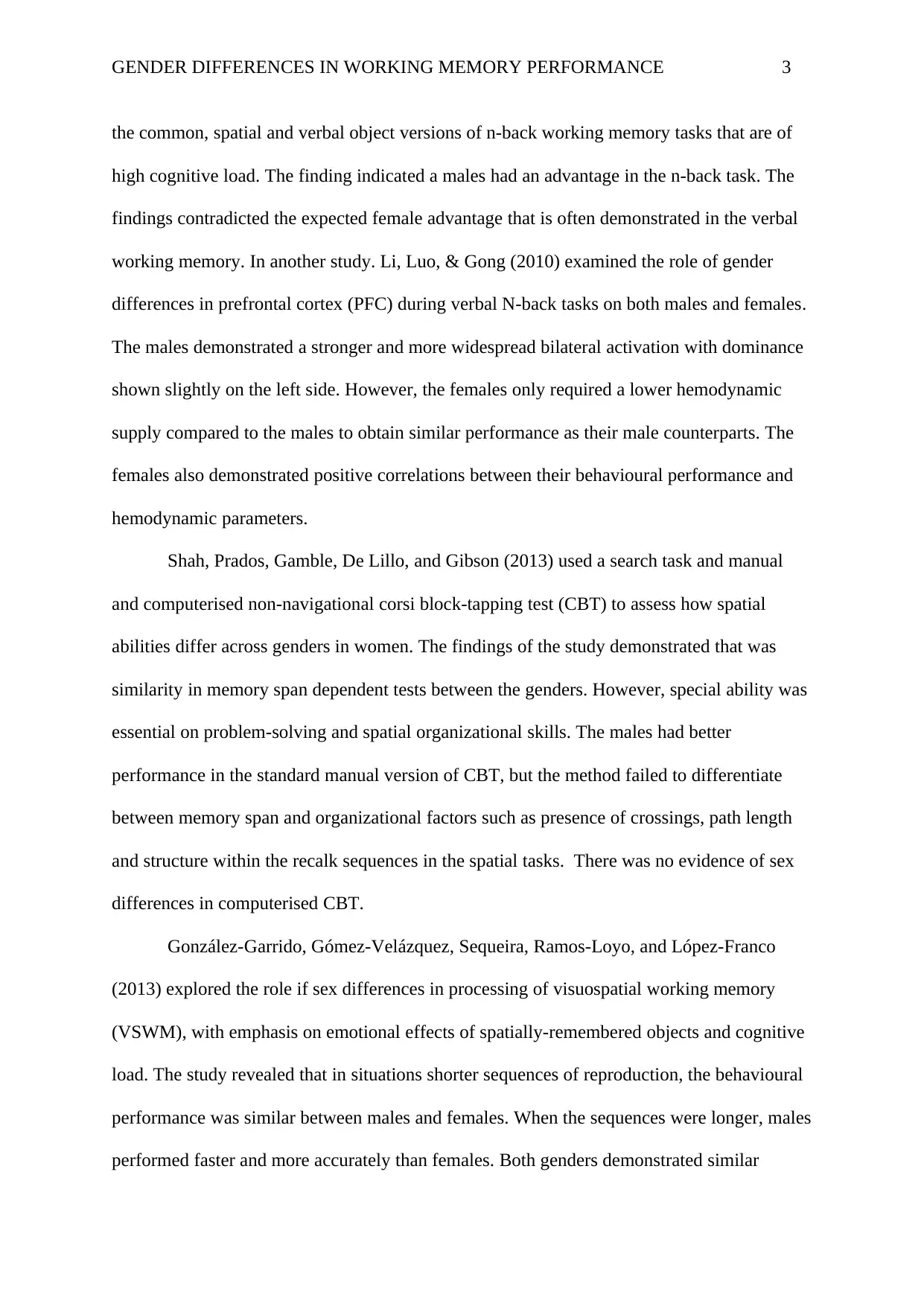
GENDER DIFFERENCES IN WORKING MEMORY PERFORMANCE 3
the common, spatial and verbal object versions of n-back working memory tasks that are of
high cognitive load. The finding indicated a males had an advantage in the n-back task. The
findings contradicted the expected female advantage that is often demonstrated in the verbal
working memory. In another study. Li, Luo, & Gong (2010) examined the role of gender
differences in prefrontal cortex (PFC) during verbal N-back tasks on both males and females.
The males demonstrated a stronger and more widespread bilateral activation with dominance
shown slightly on the left side. However, the females only required a lower hemodynamic
supply compared to the males to obtain similar performance as their male counterparts. The
females also demonstrated positive correlations between their behavioural performance and
hemodynamic parameters.
Shah, Prados, Gamble, De Lillo, and Gibson (2013) used a search task and manual
and computerised non-navigational corsi block-tapping test (CBT) to assess how spatial
abilities differ across genders in women. The findings of the study demonstrated that was
similarity in memory span dependent tests between the genders. However, special ability was
essential on problem-solving and spatial organizational skills. The males had better
performance in the standard manual version of CBT, but the method failed to differentiate
between memory span and organizational factors such as presence of crossings, path length
and structure within the recalk sequences in the spatial tasks. There was no evidence of sex
differences in computerised CBT.
González-Garrido, Gómez-Velázquez, Sequeira, Ramos-Loyo, and López-Franco
(2013) explored the role if sex differences in processing of visuospatial working memory
(VSWM), with emphasis on emotional effects of spatially-remembered objects and cognitive
load. The study revealed that in situations shorter sequences of reproduction, the behavioural
performance was similar between males and females. When the sequences were longer, males
performed faster and more accurately than females. Both genders demonstrated similar
the common, spatial and verbal object versions of n-back working memory tasks that are of
high cognitive load. The finding indicated a males had an advantage in the n-back task. The
findings contradicted the expected female advantage that is often demonstrated in the verbal
working memory. In another study. Li, Luo, & Gong (2010) examined the role of gender
differences in prefrontal cortex (PFC) during verbal N-back tasks on both males and females.
The males demonstrated a stronger and more widespread bilateral activation with dominance
shown slightly on the left side. However, the females only required a lower hemodynamic
supply compared to the males to obtain similar performance as their male counterparts. The
females also demonstrated positive correlations between their behavioural performance and
hemodynamic parameters.
Shah, Prados, Gamble, De Lillo, and Gibson (2013) used a search task and manual
and computerised non-navigational corsi block-tapping test (CBT) to assess how spatial
abilities differ across genders in women. The findings of the study demonstrated that was
similarity in memory span dependent tests between the genders. However, special ability was
essential on problem-solving and spatial organizational skills. The males had better
performance in the standard manual version of CBT, but the method failed to differentiate
between memory span and organizational factors such as presence of crossings, path length
and structure within the recalk sequences in the spatial tasks. There was no evidence of sex
differences in computerised CBT.
González-Garrido, Gómez-Velázquez, Sequeira, Ramos-Loyo, and López-Franco
(2013) explored the role if sex differences in processing of visuospatial working memory
(VSWM), with emphasis on emotional effects of spatially-remembered objects and cognitive
load. The study revealed that in situations shorter sequences of reproduction, the behavioural
performance was similar between males and females. When the sequences were longer, males
performed faster and more accurately than females. Both genders demonstrated similar
⊘ This is a preview!⊘
Do you want full access?
Subscribe today to unlock all pages.

Trusted by 1+ million students worldwide
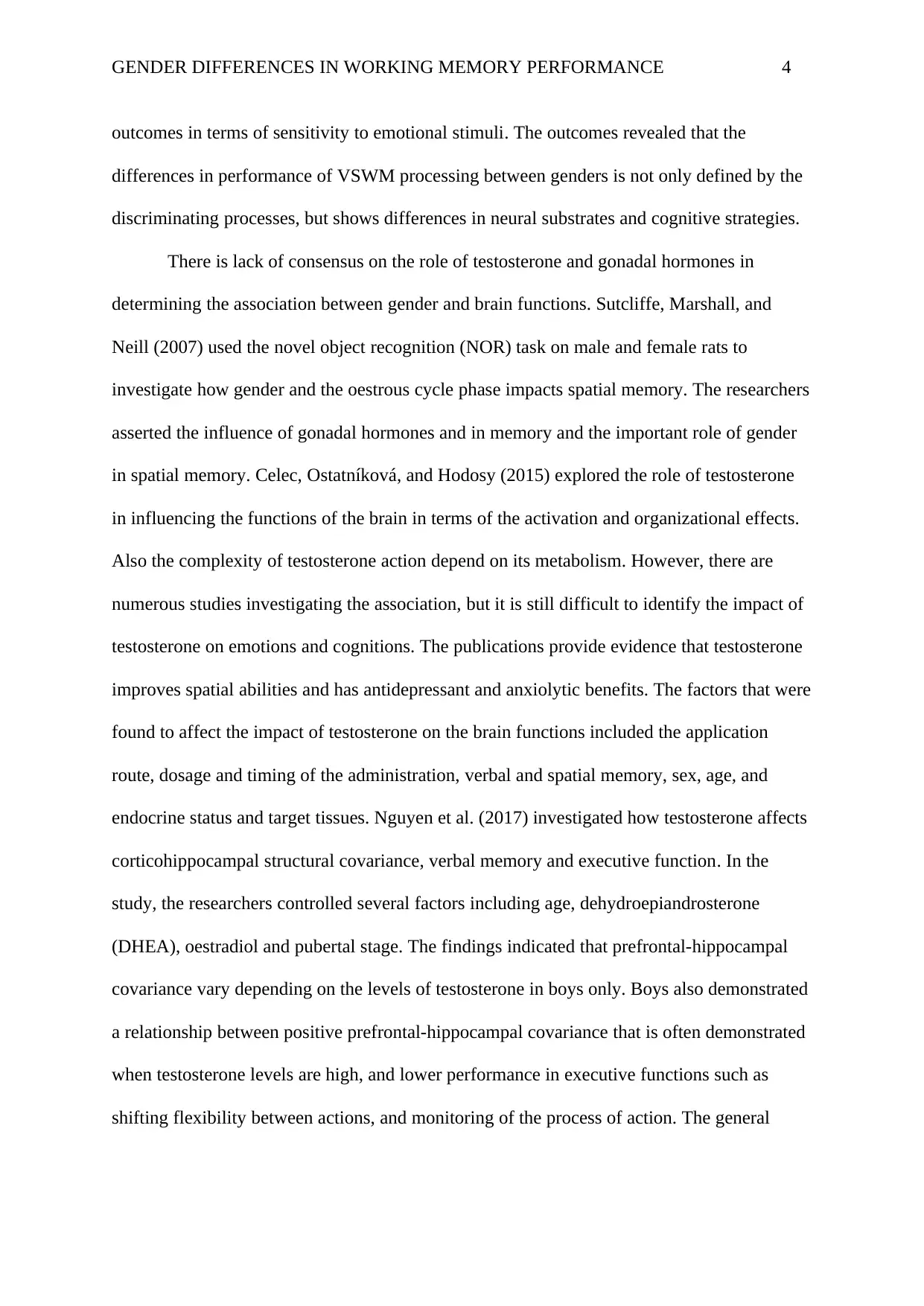
GENDER DIFFERENCES IN WORKING MEMORY PERFORMANCE 4
outcomes in terms of sensitivity to emotional stimuli. The outcomes revealed that the
differences in performance of VSWM processing between genders is not only defined by the
discriminating processes, but shows differences in neural substrates and cognitive strategies.
There is lack of consensus on the role of testosterone and gonadal hormones in
determining the association between gender and brain functions. Sutcliffe, Marshall, and
Neill (2007) used the novel object recognition (NOR) task on male and female rats to
investigate how gender and the oestrous cycle phase impacts spatial memory. The researchers
asserted the influence of gonadal hormones and in memory and the important role of gender
in spatial memory. Celec, Ostatníková, and Hodosy (2015) explored the role of testosterone
in influencing the functions of the brain in terms of the activation and organizational effects.
Also the complexity of testosterone action depend on its metabolism. However, there are
numerous studies investigating the association, but it is still difficult to identify the impact of
testosterone on emotions and cognitions. The publications provide evidence that testosterone
improves spatial abilities and has antidepressant and anxiolytic benefits. The factors that were
found to affect the impact of testosterone on the brain functions included the application
route, dosage and timing of the administration, verbal and spatial memory, sex, age, and
endocrine status and target tissues. Nguyen et al. (2017) investigated how testosterone affects
corticohippocampal structural covariance, verbal memory and executive function. In the
study, the researchers controlled several factors including age, dehydroepiandrosterone
(DHEA), oestradiol and pubertal stage. The findings indicated that prefrontal-hippocampal
covariance vary depending on the levels of testosterone in boys only. Boys also demonstrated
a relationship between positive prefrontal-hippocampal covariance that is often demonstrated
when testosterone levels are high, and lower performance in executive functions such as
shifting flexibility between actions, and monitoring of the process of action. The general
outcomes in terms of sensitivity to emotional stimuli. The outcomes revealed that the
differences in performance of VSWM processing between genders is not only defined by the
discriminating processes, but shows differences in neural substrates and cognitive strategies.
There is lack of consensus on the role of testosterone and gonadal hormones in
determining the association between gender and brain functions. Sutcliffe, Marshall, and
Neill (2007) used the novel object recognition (NOR) task on male and female rats to
investigate how gender and the oestrous cycle phase impacts spatial memory. The researchers
asserted the influence of gonadal hormones and in memory and the important role of gender
in spatial memory. Celec, Ostatníková, and Hodosy (2015) explored the role of testosterone
in influencing the functions of the brain in terms of the activation and organizational effects.
Also the complexity of testosterone action depend on its metabolism. However, there are
numerous studies investigating the association, but it is still difficult to identify the impact of
testosterone on emotions and cognitions. The publications provide evidence that testosterone
improves spatial abilities and has antidepressant and anxiolytic benefits. The factors that were
found to affect the impact of testosterone on the brain functions included the application
route, dosage and timing of the administration, verbal and spatial memory, sex, age, and
endocrine status and target tissues. Nguyen et al. (2017) investigated how testosterone affects
corticohippocampal structural covariance, verbal memory and executive function. In the
study, the researchers controlled several factors including age, dehydroepiandrosterone
(DHEA), oestradiol and pubertal stage. The findings indicated that prefrontal-hippocampal
covariance vary depending on the levels of testosterone in boys only. Boys also demonstrated
a relationship between positive prefrontal-hippocampal covariance that is often demonstrated
when testosterone levels are high, and lower performance in executive functions such as
shifting flexibility between actions, and monitoring of the process of action. The general
Paraphrase This Document
Need a fresh take? Get an instant paraphrase of this document with our AI Paraphraser
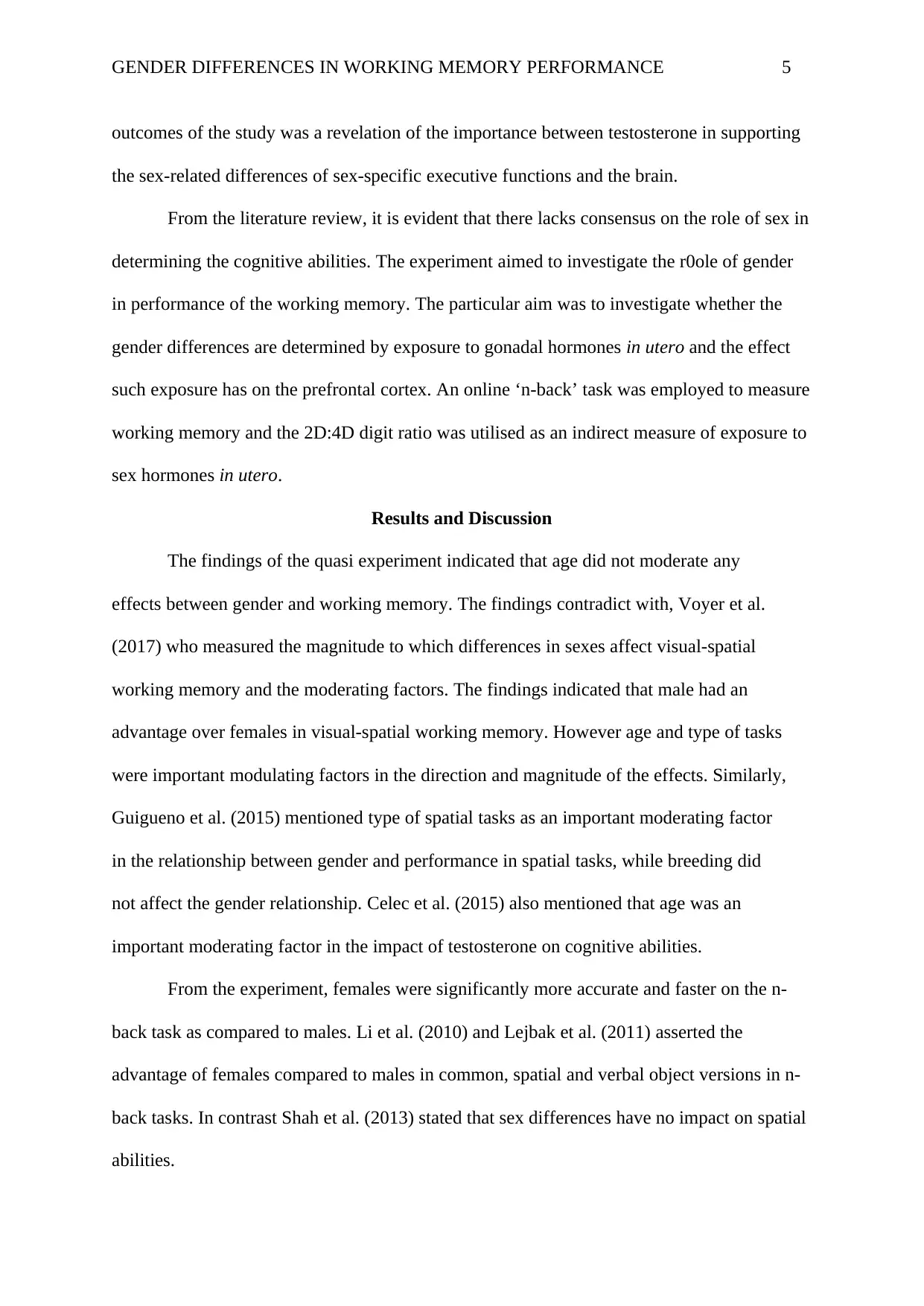
GENDER DIFFERENCES IN WORKING MEMORY PERFORMANCE 5
outcomes of the study was a revelation of the importance between testosterone in supporting
the sex-related differences of sex-specific executive functions and the brain.
From the literature review, it is evident that there lacks consensus on the role of sex in
determining the cognitive abilities. The experiment aimed to investigate the r0ole of gender
in performance of the working memory. The particular aim was to investigate whether the
gender differences are determined by exposure to gonadal hormones in utero and the effect
such exposure has on the prefrontal cortex. An online ‘n-back’ task was employed to measure
working memory and the 2D:4D digit ratio was utilised as an indirect measure of exposure to
sex hormones in utero.
Results and Discussion
The findings of the quasi experiment indicated that age did not moderate any
effects between gender and working memory. The findings contradict with, Voyer et al.
(2017) who measured the magnitude to which differences in sexes affect visual-spatial
working memory and the moderating factors. The findings indicated that male had an
advantage over females in visual-spatial working memory. However age and type of tasks
were important modulating factors in the direction and magnitude of the effects. Similarly,
Guigueno et al. (2015) mentioned type of spatial tasks as an important moderating factor
in the relationship between gender and performance in spatial tasks, while breeding did
not affect the gender relationship. Celec et al. (2015) also mentioned that age was an
important moderating factor in the impact of testosterone on cognitive abilities.
From the experiment, females were significantly more accurate and faster on the n-
back task as compared to males. Li et al. (2010) and Lejbak et al. (2011) asserted the
advantage of females compared to males in common, spatial and verbal object versions in n-
back tasks. In contrast Shah et al. (2013) stated that sex differences have no impact on spatial
abilities.
outcomes of the study was a revelation of the importance between testosterone in supporting
the sex-related differences of sex-specific executive functions and the brain.
From the literature review, it is evident that there lacks consensus on the role of sex in
determining the cognitive abilities. The experiment aimed to investigate the r0ole of gender
in performance of the working memory. The particular aim was to investigate whether the
gender differences are determined by exposure to gonadal hormones in utero and the effect
such exposure has on the prefrontal cortex. An online ‘n-back’ task was employed to measure
working memory and the 2D:4D digit ratio was utilised as an indirect measure of exposure to
sex hormones in utero.
Results and Discussion
The findings of the quasi experiment indicated that age did not moderate any
effects between gender and working memory. The findings contradict with, Voyer et al.
(2017) who measured the magnitude to which differences in sexes affect visual-spatial
working memory and the moderating factors. The findings indicated that male had an
advantage over females in visual-spatial working memory. However age and type of tasks
were important modulating factors in the direction and magnitude of the effects. Similarly,
Guigueno et al. (2015) mentioned type of spatial tasks as an important moderating factor
in the relationship between gender and performance in spatial tasks, while breeding did
not affect the gender relationship. Celec et al. (2015) also mentioned that age was an
important moderating factor in the impact of testosterone on cognitive abilities.
From the experiment, females were significantly more accurate and faster on the n-
back task as compared to males. Li et al. (2010) and Lejbak et al. (2011) asserted the
advantage of females compared to males in common, spatial and verbal object versions in n-
back tasks. In contrast Shah et al. (2013) stated that sex differences have no impact on spatial
abilities.
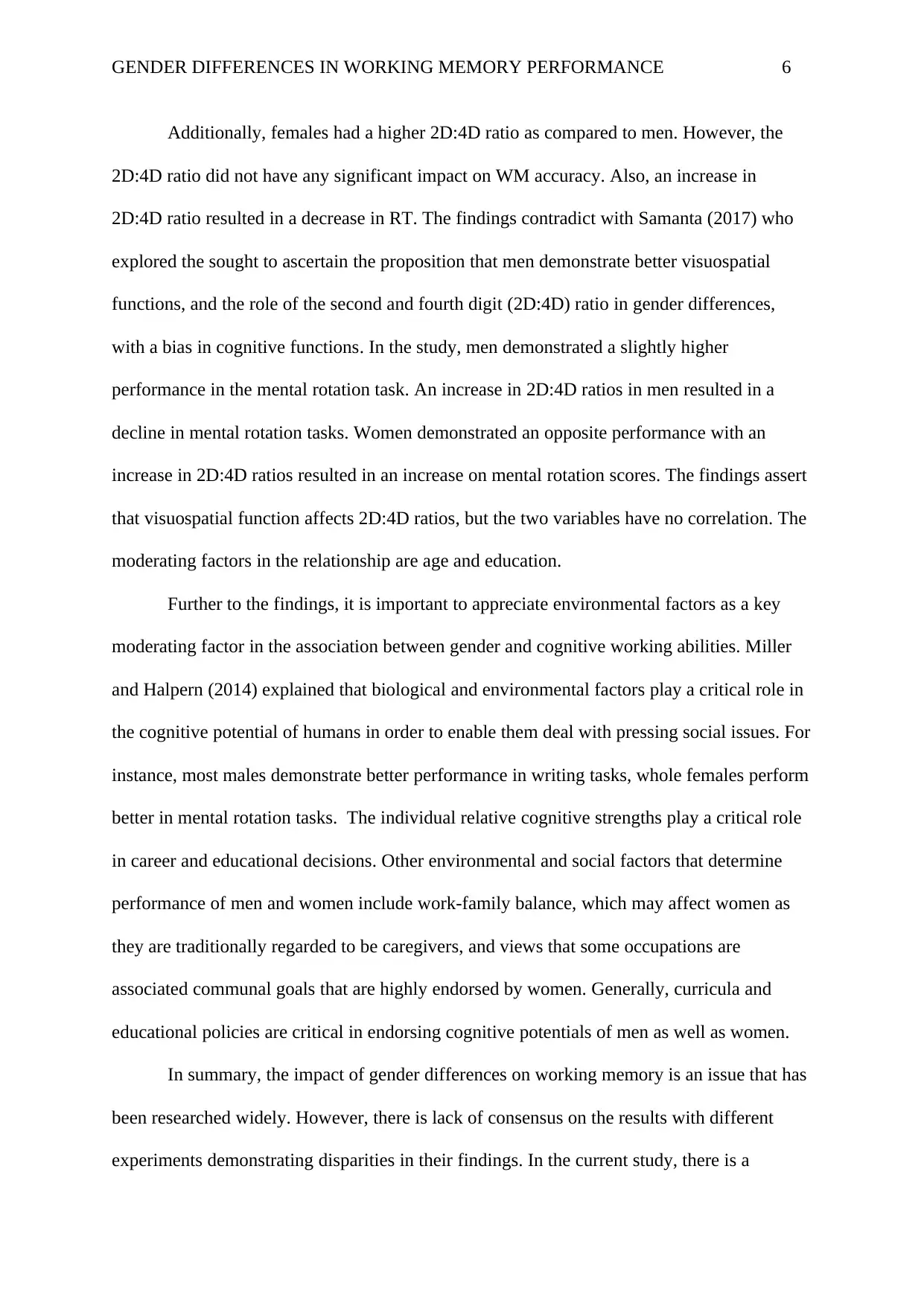
GENDER DIFFERENCES IN WORKING MEMORY PERFORMANCE 6
Additionally, females had a higher 2D:4D ratio as compared to men. However, the
2D:4D ratio did not have any significant impact on WM accuracy. Also, an increase in
2D:4D ratio resulted in a decrease in RT. The findings contradict with Samanta (2017) who
explored the sought to ascertain the proposition that men demonstrate better visuospatial
functions, and the role of the second and fourth digit (2D:4D) ratio in gender differences,
with a bias in cognitive functions. In the study, men demonstrated a slightly higher
performance in the mental rotation task. An increase in 2D:4D ratios in men resulted in a
decline in mental rotation tasks. Women demonstrated an opposite performance with an
increase in 2D:4D ratios resulted in an increase on mental rotation scores. The findings assert
that visuospatial function affects 2D:4D ratios, but the two variables have no correlation. The
moderating factors in the relationship are age and education.
Further to the findings, it is important to appreciate environmental factors as a key
moderating factor in the association between gender and cognitive working abilities. Miller
and Halpern (2014) explained that biological and environmental factors play a critical role in
the cognitive potential of humans in order to enable them deal with pressing social issues. For
instance, most males demonstrate better performance in writing tasks, whole females perform
better in mental rotation tasks. The individual relative cognitive strengths play a critical role
in career and educational decisions. Other environmental and social factors that determine
performance of men and women include work-family balance, which may affect women as
they are traditionally regarded to be caregivers, and views that some occupations are
associated communal goals that are highly endorsed by women. Generally, curricula and
educational policies are critical in endorsing cognitive potentials of men as well as women.
In summary, the impact of gender differences on working memory is an issue that has
been researched widely. However, there is lack of consensus on the results with different
experiments demonstrating disparities in their findings. In the current study, there is a
Additionally, females had a higher 2D:4D ratio as compared to men. However, the
2D:4D ratio did not have any significant impact on WM accuracy. Also, an increase in
2D:4D ratio resulted in a decrease in RT. The findings contradict with Samanta (2017) who
explored the sought to ascertain the proposition that men demonstrate better visuospatial
functions, and the role of the second and fourth digit (2D:4D) ratio in gender differences,
with a bias in cognitive functions. In the study, men demonstrated a slightly higher
performance in the mental rotation task. An increase in 2D:4D ratios in men resulted in a
decline in mental rotation tasks. Women demonstrated an opposite performance with an
increase in 2D:4D ratios resulted in an increase on mental rotation scores. The findings assert
that visuospatial function affects 2D:4D ratios, but the two variables have no correlation. The
moderating factors in the relationship are age and education.
Further to the findings, it is important to appreciate environmental factors as a key
moderating factor in the association between gender and cognitive working abilities. Miller
and Halpern (2014) explained that biological and environmental factors play a critical role in
the cognitive potential of humans in order to enable them deal with pressing social issues. For
instance, most males demonstrate better performance in writing tasks, whole females perform
better in mental rotation tasks. The individual relative cognitive strengths play a critical role
in career and educational decisions. Other environmental and social factors that determine
performance of men and women include work-family balance, which may affect women as
they are traditionally regarded to be caregivers, and views that some occupations are
associated communal goals that are highly endorsed by women. Generally, curricula and
educational policies are critical in endorsing cognitive potentials of men as well as women.
In summary, the impact of gender differences on working memory is an issue that has
been researched widely. However, there is lack of consensus on the results with different
experiments demonstrating disparities in their findings. In the current study, there is a
⊘ This is a preview!⊘
Do you want full access?
Subscribe today to unlock all pages.

Trusted by 1+ million students worldwide
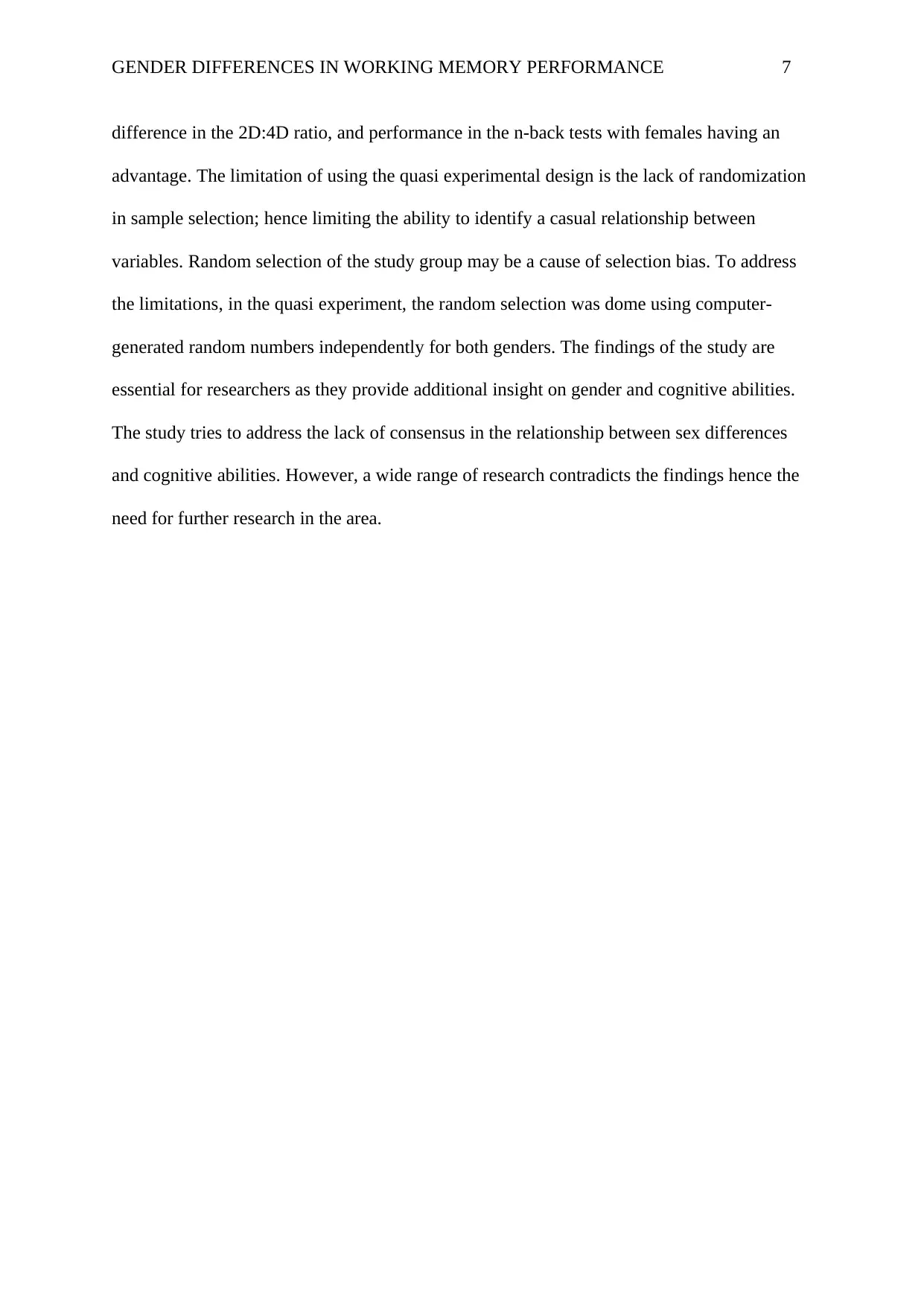
GENDER DIFFERENCES IN WORKING MEMORY PERFORMANCE 7
difference in the 2D:4D ratio, and performance in the n-back tests with females having an
advantage. The limitation of using the quasi experimental design is the lack of randomization
in sample selection; hence limiting the ability to identify a casual relationship between
variables. Random selection of the study group may be a cause of selection bias. To address
the limitations, in the quasi experiment, the random selection was dome using computer-
generated random numbers independently for both genders. The findings of the study are
essential for researchers as they provide additional insight on gender and cognitive abilities.
The study tries to address the lack of consensus in the relationship between sex differences
and cognitive abilities. However, a wide range of research contradicts the findings hence the
need for further research in the area.
difference in the 2D:4D ratio, and performance in the n-back tests with females having an
advantage. The limitation of using the quasi experimental design is the lack of randomization
in sample selection; hence limiting the ability to identify a casual relationship between
variables. Random selection of the study group may be a cause of selection bias. To address
the limitations, in the quasi experiment, the random selection was dome using computer-
generated random numbers independently for both genders. The findings of the study are
essential for researchers as they provide additional insight on gender and cognitive abilities.
The study tries to address the lack of consensus in the relationship between sex differences
and cognitive abilities. However, a wide range of research contradicts the findings hence the
need for further research in the area.
Paraphrase This Document
Need a fresh take? Get an instant paraphrase of this document with our AI Paraphraser
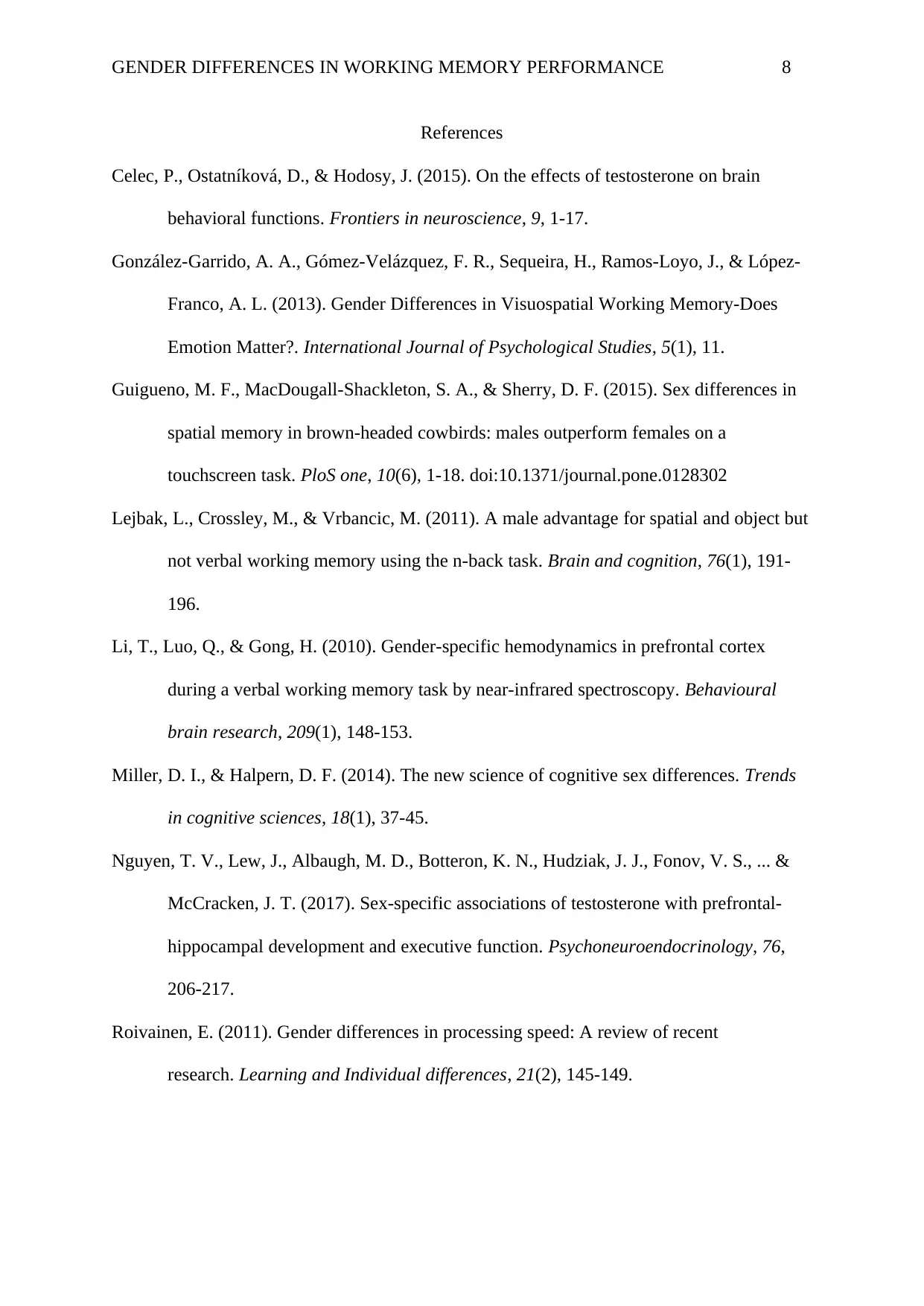
GENDER DIFFERENCES IN WORKING MEMORY PERFORMANCE 8
References
Celec, P., Ostatníková, D., & Hodosy, J. (2015). On the effects of testosterone on brain
behavioral functions. Frontiers in neuroscience, 9, 1-17.
González-Garrido, A. A., Gómez-Velázquez, F. R., Sequeira, H., Ramos-Loyo, J., & López-
Franco, A. L. (2013). Gender Differences in Visuospatial Working Memory-Does
Emotion Matter?. International Journal of Psychological Studies, 5(1), 11.
Guigueno, M. F., MacDougall-Shackleton, S. A., & Sherry, D. F. (2015). Sex differences in
spatial memory in brown-headed cowbirds: males outperform females on a
touchscreen task. PloS one, 10(6), 1-18. doi:10.1371/journal.pone.0128302
Lejbak, L., Crossley, M., & Vrbancic, M. (2011). A male advantage for spatial and object but
not verbal working memory using the n-back task. Brain and cognition, 76(1), 191-
196.
Li, T., Luo, Q., & Gong, H. (2010). Gender-specific hemodynamics in prefrontal cortex
during a verbal working memory task by near-infrared spectroscopy. Behavioural
brain research, 209(1), 148-153.
Miller, D. I., & Halpern, D. F. (2014). The new science of cognitive sex differences. Trends
in cognitive sciences, 18(1), 37-45.
Nguyen, T. V., Lew, J., Albaugh, M. D., Botteron, K. N., Hudziak, J. J., Fonov, V. S., ... &
McCracken, J. T. (2017). Sex-specific associations of testosterone with prefrontal-
hippocampal development and executive function. Psychoneuroendocrinology, 76,
206-217.
Roivainen, E. (2011). Gender differences in processing speed: A review of recent
research. Learning and Individual differences, 21(2), 145-149.
References
Celec, P., Ostatníková, D., & Hodosy, J. (2015). On the effects of testosterone on brain
behavioral functions. Frontiers in neuroscience, 9, 1-17.
González-Garrido, A. A., Gómez-Velázquez, F. R., Sequeira, H., Ramos-Loyo, J., & López-
Franco, A. L. (2013). Gender Differences in Visuospatial Working Memory-Does
Emotion Matter?. International Journal of Psychological Studies, 5(1), 11.
Guigueno, M. F., MacDougall-Shackleton, S. A., & Sherry, D. F. (2015). Sex differences in
spatial memory in brown-headed cowbirds: males outperform females on a
touchscreen task. PloS one, 10(6), 1-18. doi:10.1371/journal.pone.0128302
Lejbak, L., Crossley, M., & Vrbancic, M. (2011). A male advantage for spatial and object but
not verbal working memory using the n-back task. Brain and cognition, 76(1), 191-
196.
Li, T., Luo, Q., & Gong, H. (2010). Gender-specific hemodynamics in prefrontal cortex
during a verbal working memory task by near-infrared spectroscopy. Behavioural
brain research, 209(1), 148-153.
Miller, D. I., & Halpern, D. F. (2014). The new science of cognitive sex differences. Trends
in cognitive sciences, 18(1), 37-45.
Nguyen, T. V., Lew, J., Albaugh, M. D., Botteron, K. N., Hudziak, J. J., Fonov, V. S., ... &
McCracken, J. T. (2017). Sex-specific associations of testosterone with prefrontal-
hippocampal development and executive function. Psychoneuroendocrinology, 76,
206-217.
Roivainen, E. (2011). Gender differences in processing speed: A review of recent
research. Learning and Individual differences, 21(2), 145-149.
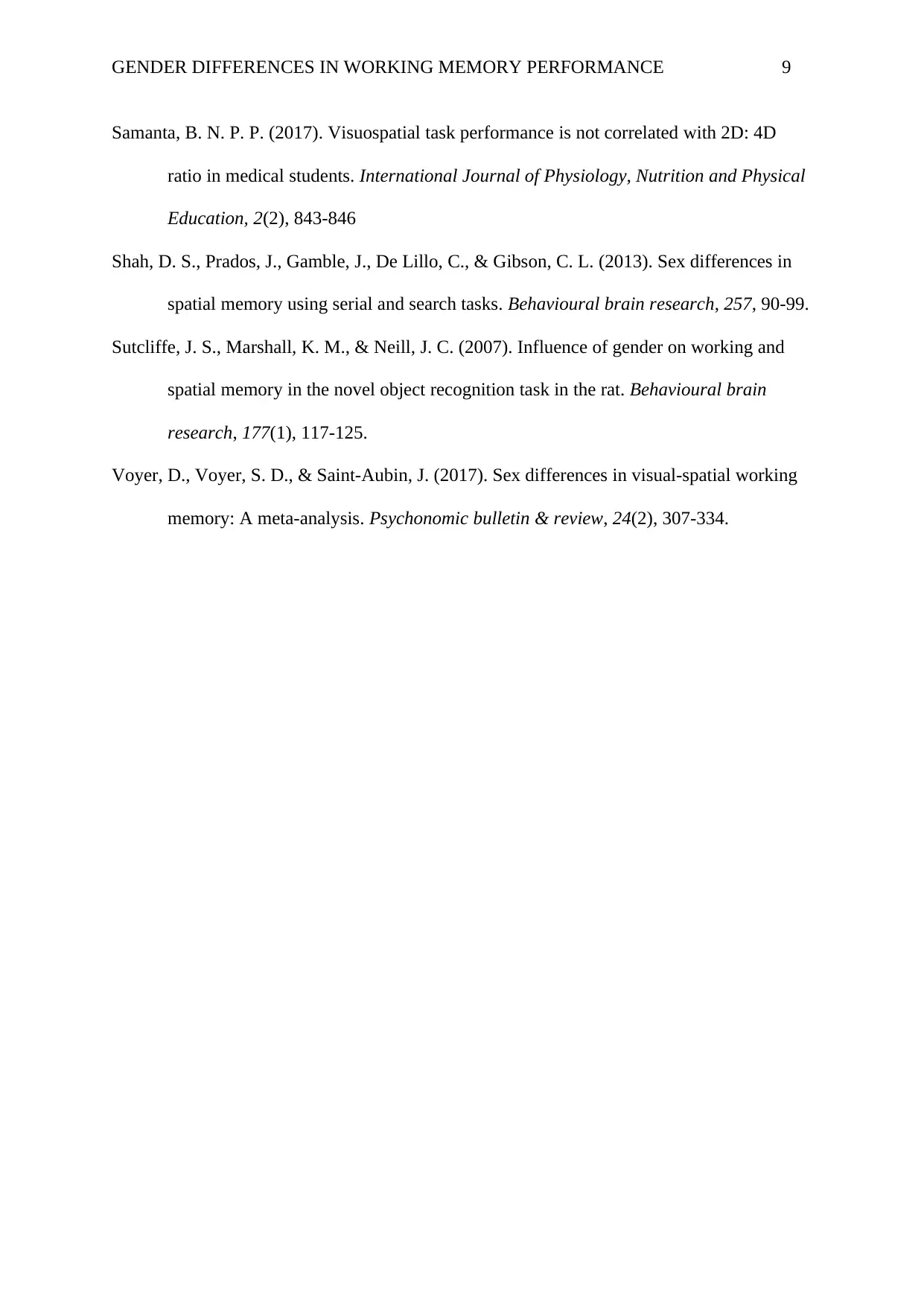
GENDER DIFFERENCES IN WORKING MEMORY PERFORMANCE 9
Samanta, B. N. P. P. (2017). Visuospatial task performance is not correlated with 2D: 4D
ratio in medical students. International Journal of Physiology, Nutrition and Physical
Education, 2(2), 843-846
Shah, D. S., Prados, J., Gamble, J., De Lillo, C., & Gibson, C. L. (2013). Sex differences in
spatial memory using serial and search tasks. Behavioural brain research, 257, 90-99.
Sutcliffe, J. S., Marshall, K. M., & Neill, J. C. (2007). Influence of gender on working and
spatial memory in the novel object recognition task in the rat. Behavioural brain
research, 177(1), 117-125.
Voyer, D., Voyer, S. D., & Saint-Aubin, J. (2017). Sex differences in visual-spatial working
memory: A meta-analysis. Psychonomic bulletin & review, 24(2), 307-334.
Samanta, B. N. P. P. (2017). Visuospatial task performance is not correlated with 2D: 4D
ratio in medical students. International Journal of Physiology, Nutrition and Physical
Education, 2(2), 843-846
Shah, D. S., Prados, J., Gamble, J., De Lillo, C., & Gibson, C. L. (2013). Sex differences in
spatial memory using serial and search tasks. Behavioural brain research, 257, 90-99.
Sutcliffe, J. S., Marshall, K. M., & Neill, J. C. (2007). Influence of gender on working and
spatial memory in the novel object recognition task in the rat. Behavioural brain
research, 177(1), 117-125.
Voyer, D., Voyer, S. D., & Saint-Aubin, J. (2017). Sex differences in visual-spatial working
memory: A meta-analysis. Psychonomic bulletin & review, 24(2), 307-334.
⊘ This is a preview!⊘
Do you want full access?
Subscribe today to unlock all pages.

Trusted by 1+ million students worldwide
1 out of 9
Related Documents
Your All-in-One AI-Powered Toolkit for Academic Success.
+13062052269
info@desklib.com
Available 24*7 on WhatsApp / Email
![[object Object]](/_next/static/media/star-bottom.7253800d.svg)
Unlock your academic potential
Copyright © 2020–2025 A2Z Services. All Rights Reserved. Developed and managed by ZUCOL.





